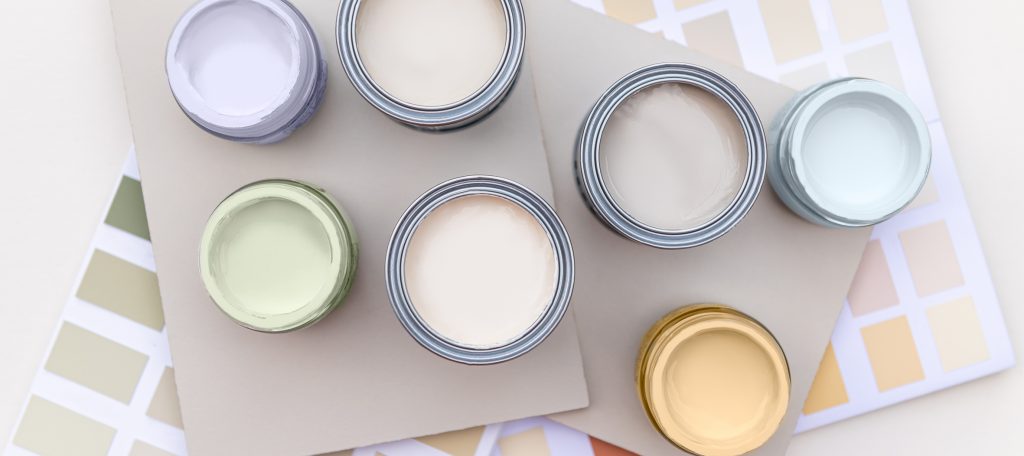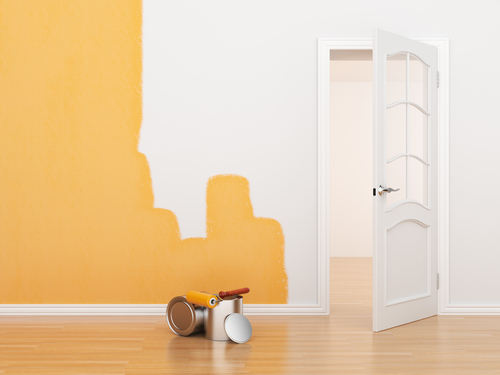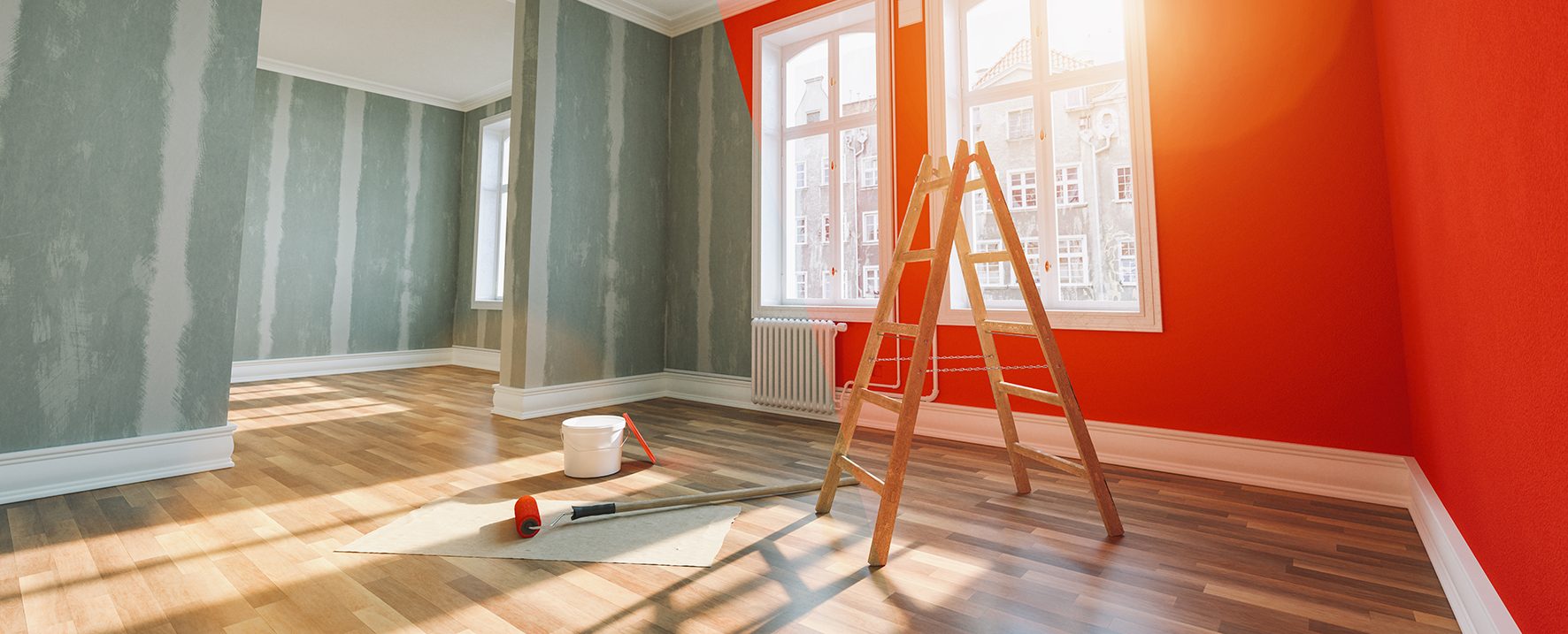The devil is often in the details. Among these details, one aspect stands out due to its transformative power: paint finishes. An understanding of paint finishes is more than just a decorative choice; it’s a fundamental element that can significantly impact both the aesthetic and functional quality of a space.

Imagine walking into a room that captures light perfectly, where every surface gleams just right, making the space feel larger, cleaner, and more refined. Conversely, think of another where imperfections are subtly concealed, imparting an ambience of cosiness and depth. Both scenarios can be achieved through the careful selection of paint finishes.
Understanding the Basics of Paint Finishes
At first glance, the many terms that can apply to paint finishes seem overwhelming, but once understood, they open the door to a world of possibilities for every space.
Definition: At its core, the concept of paint sheens and finishes refers to the level of glossiness or shine a paint exhibits once dry. This finish is not just about aesthetics but also about the tactile feel of the painted surface and its practical attributes.
The Role of Sheen: Essentially, sheen is the light-reflective quality of the paint. The higher the sheen, the shinier or glossier the paint appears. But it’s not just about the visual effect; sheen has functional implications too. A paint with a higher sheen level tends to be more durable and easier to clean. This makes it ideal for areas of the home that see a lot of traffic or are prone to messes, such as kitchens and bathrooms.
General Rule: As a foundational understanding, it’s essential to know that a higher gloss often equates to increased durability and ease of cleaning. This means such paints are more resistant to wear and tear, and any dirt or stains can be wiped away more comfortably. However, there’s a trade-off. These high-sheen paints are also more likely to highlight imperfections on the surface, be it a dent on a wall or an uneven brush stroke. Due to their reflective nature, they might show more dirt and fingerprints, especially in high-traffic areas.
The Spectrum of Paint Finishes
Choosing the right paint finish can make a world of difference in the ambience of a room. Here’s a breakdown of the spectrum of paint finishes to guide you through your next painting project:

Flat & Matte Finish
- Description: This finish is the least reflective, offering a smooth, muted look on walls. It’s particularly prized for its ability to hide minor wall blemishes and imperfections, allowing for a more uniform appearance.
- Pros and Cons: The major advantage is its camouflage capability, making it a favourite for older homes or imperfect surfaces. However, the downside is its vulnerability to marks and its resistance to cleaning. Scrubbing a matte-finished wall can result in a faded spot, making maintenance a challenge.
- Best for: Spaces that demand a serene and formal ambience, such as formal living rooms, adult bedrooms, dining rooms, and ceilings. It’s especially suited for low-traffic areas where there’s minimal contact with the walls.
Eggshell Finish
- Description: Named for its resemblance to an egg’s surface, this finish strikes a balance between matte and glossy. It offers a hint of shine, adding depth and warmth to a space.
- Pros and Cons: With its slight sheen, eggshell is more durable and stain-resistant than flat finishes, making cleaning less challenging. However, touch-ups might be noticeable, so care is required when addressing wall marks.
- Best for: Versatile in nature, it’s suitable for family rooms, dining rooms, home offices, bedrooms, and entryways.
Satin Finish

- Description: Characterized by a soft, velvety glow, satin finishes sit between eggshell and semi-gloss in terms of sheen. It’s often described as having a pearl-like lustre.
- Pros and Cons: Satin offers higher durability and is more moisture and stain-resistant than eggshell. Its reflective nature can create a warm ambience. However, it might accentuate any application errors, such as brush or roller marks.
- Best for: Ideal for living rooms, children’s rooms, hallways, kitchens, and bathrooms where some moisture might be present.
Semi-Gloss Finish
- Description: A step shinier than satin, semi-gloss finishes are known for their crisp, polished look.
- Pros and Cons: This finish is durable, moisture-resistant, and easy to clean, making it a top choice for spaces that need regular cleaning. However, its shine can cause a glare under intense lighting and might highlight wall imperfections.
- Best for: Spaces that experience heavy use or moisture, such as kitchens, bathrooms, and children’s rooms. It’s also a favoured choice for trim and doors.
High-Gloss Finish
- Description: The boldest statement in the paint finish spectrum, high-gloss paints are ultra-shiny, reflecting light intensely and offering a sleek, almost mirror-like appearance.
- Pros and Cons: Its major strength lies in its durability and ease of cleaning. However, this extreme shine can amplify any surface imperfections. It’s often recommended to have professionals apply this finish for the best outcome.
- Best for: Areas that demand both style and durability, like kitchens, bathrooms, doors, trim, and mouldings. Given its attention-grabbing nature, it can also be used for accent walls or features.
Specialized Paint Finishes
Paint is not just limited to the usual spectrum of finishes. For those looking to break the mould or bring a special touch to their interior designs, specialized paint finishes come into play. They’re not just about the aesthetics; they offer unique features suited for specific projects.
Chalk, Milk, and Limewash Paints – Descriptions and Best Uses
- Chalk Paint: A matte, velvety paint known for its ease of use, especially in furniture upcycling projects. It can be applied to various surfaces without much preparation and is known for its distressing capabilities.
- Milk Paint: This is an ancient paint made from simple ingredients, including milk. It provides a deep, rich colour and is often used in period or historic homes. Its porous nature makes it a good choice for wood surfaces.
- Limewash Paint: A breathable finish that’s been used for centuries, limewash is known for its soft, weathered patina. It’s great for porous surfaces like brick and stone.
Expert Opinions: Annie Sloan, a renowned expert in the field, revolutionized the painting world with her branded Chalk Paint. She praises its versatility and emphasizes that its rich, matte look is not only beautiful but also user-friendly, making DIY projects more accessible to novices.
Clay, Distemper, and Specialist Paints – Descriptions and Best Uses
- Clay Paint: Made from natural earth materials, clay paint provides a unique, breathable finish. It’s ideal for older properties with potential moisture issues and works well on feature walls, offering a subtle, textured look.
- Distemper: A paint of historic significance, distemper is a water-based finish that provides a soft, velvety touch. It’s mainly used for restoration projects or in historic buildings.
- Specialist Paints: These can encompass a range of unique paints tailored for specific needs – from magnetic paints to glow-in-the-dark finishes. Their application varies widely based on the unique features they offer.
Expert Opinion: Experts often highlight the benefits of using natural paints like clay for their eco-friendly attributes. Not only are they made from sustainable materials, but their breathable nature ensures that walls don’t trap moisture, aiding in the longevity of the finish and overall health of the structure.
Factors to Consider When Choosing a Paint Finish

The vibrant colour you’ve chosen for your room is only half the story. The finish or sheen of the paint plays an equally critical role in achieving the desired effect. Selecting the right paint finish ensures that the paint job lasts longer and fulfils its aesthetic potential. Here’s what you should take into account:
Durability & Maintenance
- One of the primary concerns when choosing a paint finish is understanding its durability and subsequent maintenance requirements. High-traffic areas such as hallways, kitchens, or children’s rooms might necessitate a more durable finish like semi-gloss or high-gloss. These finishes are not only more resistant to scuffs and marks but are also easier to clean.
- On the other hand, less frequented spaces might do well with matte or eggshell finishes, which offer less durability but a subtler, more elegant appearance.
Room Function
- Different rooms serve different purposes and are exposed to varied conditions. A bathroom, for instance, is subject to high moisture levels, making a moisture-resistant finish, like semi-gloss or high-gloss, a wise choice.
- Living rooms, however, might benefit from a satin or eggshell finish, which offers a moderate sheen that’s both elegant and reasonably durable.
- Bedrooms might lean towards matte finishes, emphasizing comfort and warmth over high durability.
Light Reflection
- The finish of a paint can dramatically influence the way light is reflected in a room. Glossy finishes will reflect light, thereby making a room feel brighter and sometimes larger. This can be especially beneficial in rooms with limited natural light.
- However, this reflection can also highlight imperfections in the wall. In contrast, matte finishes absorb light, providing a more muted, cosy ambience. They’re great for hiding those small wall imperfections but might darken a room slightly.
- Understanding the play of light in your space can guide you in selecting a finish that either capitalizes on or mitigates its effects.
Conclusion
The choice of paint finish is a crucial yet often overlooked component. As we’ve seen, the finish not only dictates the visual appeal of a space but also determines its functional longevity. From the sophisticated matte finishes that cloak imperfections to the reflective high-gloss choices that breathe life into a room, every finish tells a story. Specialized finishes further extend the palette of possibilities, bringing history, texture, or even sustainability into the mix.
When it’s time to wield that paintbrush or roller, remember that you’re not just adding colour to a wall—you’re imbuing a space with character, feel, and function. Like the final brushstroke in a masterpiece, the right paint finish can elevate a space from ordinary to extraordinary, creating an environment that resonates with both its inhabitants and guests. Choose wisely, and let your walls speak volumes.





